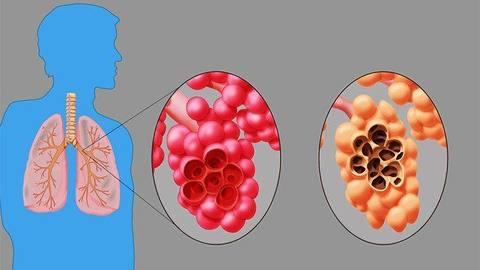Emphysema And COPD
EMPHYSEMA AND COPD
By Joseph Bennington-Castro Medically Reviewed by Sanjai Sinha, MD
Emphysema occurs when air sacs of the lungs known as alveoli become damaged and enlarged. Emphysema is one of the two main types of chronic obstructive pulmonary disease (COPD), a group of progressive respiratory diseases that cause airflow blockage and breathing difficulties.
According to the National Heart, Lung, and Blood Institute (NHBLI), most people with COPD suffer from both emphysema and chronic bronchitis (1). More than 3 million people in the United States have been diagnosed with emphysema, and more than 11 million have COPD. The disease is most common in men between the ages of 50 and 70. (2)
What Is Emphysema?
Emphysema occurs when the air sacs of the lungs (alveoli) become damaged and enlarged, causing breathlessness. Each lung has an average of 480 million alveoli, according to a report in the American Journal of Respiratory and Critical Care Medicine.(3)
When you breathe in, the alveoli expand and stretch, taking in oxygen and transporting it to the blood in the small capillary vessels within their thin walls. At the same time, carbon dioxide waste moves into the air sacs from the capillaries, a process called gas exchange.
When you breathe out, the alveoli easily deflate, expelling the carbon dioxide out of the body through the airways.
But for people with emphysema, the alveolar walls are damaged and the air sacs lose their normal elasticity, causing the airways to the lungs (bronchioles) to collapse. The inelasticity of the alveoli and the narrowed bronchioles make it difficult for people with emphysema to fully expel all of the air out of their lungs. Additionally, emphysema can cause some of the alveoli to rupture or burst, resulting in fewer, larger alveoli and ultimately reducing the surface area available for gas exchange.
What Causes Emphysema?
Emphysema is considered one of the most preventable respiratory diseases because cigarette smoking is its leading cause. According to the American Lung Association, between 85 percent and 90 percent of all COPD cases are caused by cigarette smoking. (4) But data from the Centers for Disease Control and Prevention estimates that 1 out of 4 Americans with COPD never smoked cigarettes. (5)
Other risk factors for emphysema include:
- Frequent childhood respiratory infections
- Asthma
- Chronic exposure to air pollution, secondhand smoke, or workplace dust and smoke
In rare cases, emphysema is caused by the hereditary disorder alpha-1 antitrypsin (A1AT) deficiency. People with A1AT deficiency don't produce enough A1AT, a protein that protects the lungs from a potentially destructive enzyme called neutrophil elastase.
The prevalence of A1AT deficiency varies by population. The disorder affects about 1 in 1,500 to 3,500 individuals with European ancestry, but it is uncommon among people of Asian descent. (6)
What Are the Symptoms of Emphysema?
Someone can have emphysema for years without noticeable signs or symptoms. In many cases, the disease is first noticed when it interferes with daily tasks. Symptoms of emphysema include:
- Shortness of breath, especially during physical activity
- Chronic cough
- Frequent respiratory infections, including acute bronchitis and pneumonia
- Wheezing
- Reduced appetite and weight loss
- Fatigue
- A blueness of the lips and fingernail beds, called cyanosis
- Barrel chest from the lungs being chronically overinflated with air
How Is Emphysema Diagnosed?
- Emphysema is generally diagnosed via tests, including:
- Spirometry, a lung-function test that measures how much air you can breathe out and how quickly you can do it.
- Chest X-rays and computerized tomography (CT) scans that can visibly detect lung damage
- Arterial blood gas test that measures the amount of oxygen and carbon dioxide in the blood from the artery
- Electrocardiogram (EKG), a heart exam to rule out heart disease as a cause of shortness of breath
- A1AT deficiency tests
How Is Emphysema Treated?
- There is no cure for COPD, but quitting smoking and undergoing treatment can reduce the progression of the disease and improve the quality of life. For emphysema, treatment options generally include:
- Medications, including bronchodilators, corticosteroids, and antibiotics (typically to treat respiratory infections)
- Oxygen therapy, if needed
- A1AT replacement therapy (infusions of the protein), if needed
- Lung surgery to remove destroyed tissue, or lung transplant, for very advanced emphysema
- Pulmonary rehabilitation, which teaches you how to better live with your disease
- Vaccines to prevent certain infections
Resources
- American Academy of Family Physicians
- American Lung Association
- American Thoracic Society
- Chest Foundation
- COPD Foundation
- National Emphysema Foundation
SUPPORT
You can also learn more about health and nutrition by joining our group Lung, COPD and Health Examiner.
A great method of easing COPD, lung symptoms, and mucus build-up is by going through our Mullein Lung Detox Programme.
Nurture lungs with the gentle power of Mullein
This site is not a part of the Facebook website or Facebook Inc. Additionally, This site is NOT endorsed by Facebook in any way. FACEBOOK is a trademark of FACEBOOK, Inc.





